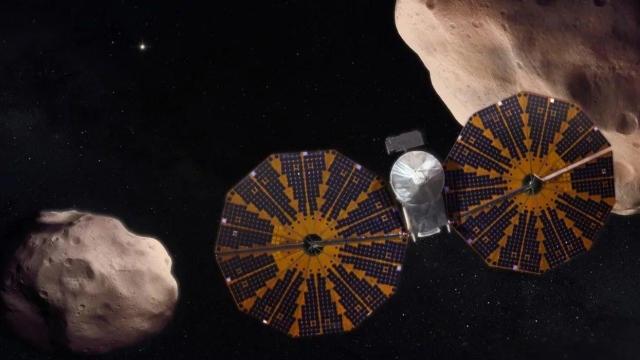Fresh off of its first asteroid encounter that revealed a bonus space rock, Lucy is now ready for the big leagues. The NASA spacecraft began maneuvering its way to Jupiter’s Trojan asteroids, travelling to a farther orbit in deep space in order to reach the Jovian system.
On Wednesday, Lucy fired its main engine for the first time in space as the first step in a series of maneuvers to change the velocity of the spacecraft so that it can reach the distant realms of the Trojan asteroids, NASA recently announced. Following its brief engine burn, the team behind the mission will analyze the spacecraft’s performance before setting it up for a larger maneuver through deep space, which will likely take place on Saturday.
The series of deep space maneuvers are meant to position Lucy for an upcoming Earth gravity assist in December, using its home planet as a slingshot towards its new trajectory. “The Lucy spacecraft will transition from its current orbit around the Sun–one that just skims the inner-edge of the main asteroid belt–to a new orbit that will carry it beyond the orbit of Jupiter and into the realm of the Trojan asteroids,” NASA wrote.
Lucy will fly within 230 miles (370 kilometres) of Earth, catapulting its way through the main asteroid belt where it will encounter asteroid Donaldjohanson in April 2025, and out into the Jupiter Trojan asteroid swarm. Lucy will begin its tour of the Trojan asteroids in 2027 by visiting Eurybates and its binary partner Queta, followed by Polymele and its binary partner, Leucus, Orus, and the binary pair Patroclus and Menoetius.
Prior to this transition, Lucy’s previous maneuvers have changed its velocity by less than 10 miles per hours (a few metres per second) and were carried out by the spacecraft’s less powerful thrusters. On its way to the Trojans, however, the asteroid probe is scaling up. The two deep space maneuvers are designed to change the velocity of the spacecraft by around 2,000 miles per hour (approximately 900 meters per second) and will consume roughly half of the spacecraft’s onboard fuel, according to NASA.
Lucy launched in October 2021 with the aim of studying the Trojan asteroids, a group of rocky bodies that lead and follow Jupiter as it orbits the Sun. The spacecraft pulled off its first asteroid encounter in November 2023, briefly rendezvousing with Dinkinesh in the main asteroid belt, which turned out to have two tiny satellites closely orbiting around it.
